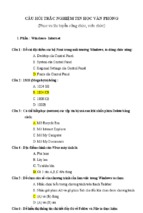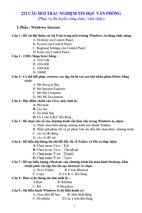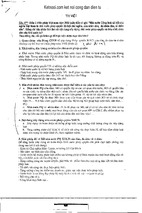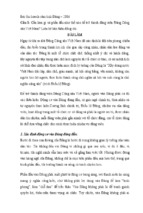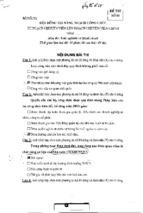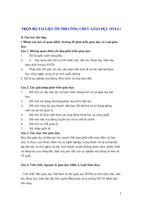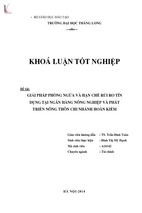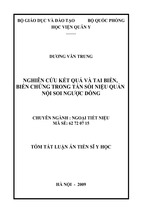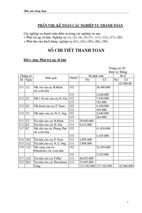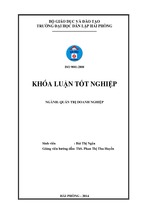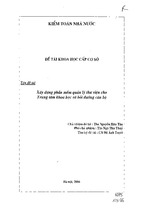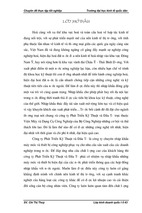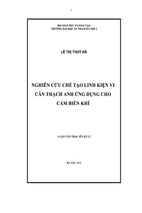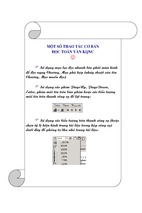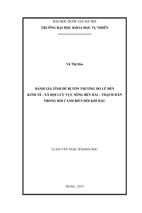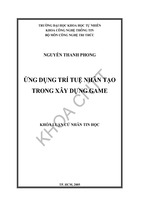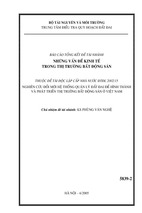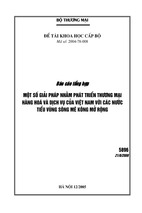This study sheds new light on the complex relationship between
cognitive and linguistic categories. Challenging the view of cases as
categories in cognitive space, Professor Schlesinger proposes a new
understanding of the concept of case. Drawing on evidence from
psycholinguistic research and English language data, he argues that case
categories are in fact composed of more primitive cognitive notions:
features and dimensions. These are registered in the lexical entries of
individual verbs, thereby allowing certain metaphorical extensions. The
features of a noun phrase may also be determined by its syntactic
function. This new approach to case permits better descriptions of
certain syntactic phenomena than have hitherto been possible, as
Schlesinger illustrates through his analysis of the feature compositions
of three cases.
This study sheds new light on the complex relationship between
cognitive and linguistic categories. Challenging the view of cases as
categories in cognitive space, Professor Schlesinger proposes a new
understanding of the concept of case. Drawing on evidence from
psycholinguistic research and English language data, he argues that case
categories are in fact composed of more primitive cognitive notions:
features and dimensions. These are registered in the lexical entries of
individual verbs, thereby allowing certain metaphorical extensions. The
features of a noun phrase may also be determined by its syntactic
function. This new approach to case permits better descriptions of
certain syntactic phenomena than have hitherto been possible, as
Schlesinger illustrates through his analysis of the feature compositions
of three cases.
STUDIES IN ENGLISH LANGUAGE
Executive Editor. Sidney Greenbaum
Advisory Editors: John Algeo, Rodney Huddleston, Magnus Ljung
Cognitive space and linguistic case
Studies in English Language
The aim of this series is to provide a framework for original studies of
present-day English. All are based securely on empirical research, and
represent theoretical and descriptive contributions to our knowledge of
national varieties of English, both written and spoken. The series will
cover a broad range of topics in English grammar, vocabulary, discourse,
and pragmatics, and is aimed at an international readership.
Already published
Christian Mair Infinitival complement clauses in English: A study of
syntax in discourse
Charles F. Meyer Apposition in contemporary English
Jan Firbas Functional sentence perspective in written and spoken
communication
Forthcoming
John Algeo
A study of British—American grammatical differences
Cognitive space and
linguistic case
Semantic and syntactic categories
in English
IZCHAK M. SCHLESINGER
Department of Psychology, The Hebrew University, Jerusalem
CAMBRIDGE
UNIVERSITY PRESS
CAMBRIDGE UNIVERSITY PRESS
Cambridge, New York, Melbourne, Madrid, Cape Town, Singapore, Sao Paulo
Cambridge University Press
The Edinburgh Building, Cambridge CB2 2RU, UK
Published in the United States of America by Cambridge University Press, New York
www.cambridge.org
Information on this title: www.cambridge.org/9780521434362
© Cambridge University Press 1995
This publication is in copyright. Subject to statutory exception
and to the provisions of relevant collective licensing agreements,
no reproduction of any part may take place without
the written permission of Cambridge University Press.
First published 1995
This digitally printed first paperback version 2006
A catalogue record for this publication is available from the British Library
Library of Congress Cataloguing in Publication data
Schlesinger, I. M.
Cognitive space and linguistic case: semantic and syntactic
categories in English / Izchak M. Schlesinger.
p. cm. - (Studies in English language)
Includes bibliographical references and index.
ISBN 0 521 43436 X (hardback)
1. English language — Grammatical categories. 2. English language—
Semantics. 3. English language — Syntax. 4. English language —
Case. I. Title. II. Series.
PE1199.S35 1995
425-dc20
95-12805
CIP
ISBN-13 978-0-521-43436-2 hardback
ISBN-10 0-521-43436-X hardback
ISBN-13 978-0-521-02736-6 paperback
ISBN-10 0-521-02736-5 paperback
For Avigail,
who made it possible
Contents
Preface
Introduction
1
page xiii
i
1
2
3
4
5
6
Cognitive space
Semantic and cognitive categories
Instrument and Accompaniment - rating studies
Ratings of Instrument, Accompaniment, and Manner
Notions expressed by with — & qualitative study
Agent and Experiencer
Cognitive space and grammar
4
4
5
12
14
21
23
1
2
3
4
5
6
7
8
Agent and subject
The semantics of the subject
Features of the Agent
Feature assignment
Case assignment
Linking
Non-agentive subjects
Converse verbs
Conclusions
28
28
30
40
45
49
52
54
57
The Comitative
fftfA-phrases
Features of noun phrases in B^Y/r-phrases
The Comitative
Linking
Studies of linking
Conclusions
60
60
61
70
75
86
91
2
3
1
2
3
4
5
6
4
Non-comitative instruments
1 The "Instrument" in subject position
2 Constraints on subjects
92
92
94
ix
x
Contents
3
4
5
6
7
5
Degree of CONTROL in the inanimate subject
Conjoining of subject noun phrases
Passives with instruments
Semantic saturation and language acquisition
Conclusions
Predicates
1 What is a predicate?
2 Phrasal predicates
3 Events and States
6
98
104
106
109
no
in
in
115
117
1
2
3
4
5
The Attributee
The subjects of States
Noun phrases that are both A-case and Attributee
Implicit Events and States
Passive sentences
Conclusions
122
122
124
126
128
138
1
2
3
4
5
6
7
8
Mental verbs
Experiencer and Stimulus - the problem
The subjects of mental verbs
The objects of mental verbs
CONTROL in the Experiencer and the Stimulus
Studies of rated CONTROL
The Event-State dichotomy of mental verbs
The linguistic realization of experiences
Conclusions
139
139
140
144
146
149
151
156
162
1
2
3
4
5
6
Objects
Direct objects
Objects of prepositions
Linking of core arguments
Deletion of prepositions
Features of verb phrases
Conclusions
163
163
167
169
173
175
179
1
2
3
4
5
6
Verb classes and Agents
Subdivisions of verbs
A proposal for a subdivision
Substitutability by pro-forms
Pseudo-cleft sentences
Accounting for the hierarchy
The agency gradient
180
180
181
183
190
192
199
7
8
9
Contents xi
7 The psychological reality of verb classes
8 Conclusions
10
1
2
3
204
209
Retrospect and prospects
The traditional view
The present approach
Prospects
210
210
211
213
Notes
215
References
227
Subject index
Author index
233
238
Preface
During the past twelve years or so I have been carrying out several linguistic
and psycholinguistic studies on the relationship between cognitive and
linguistic categories. The impetus for summarizing this work in book form
came from Sidney Greenbaum. I then had to embark on the task of spelling
out and developing the theoretical approach underlying my previous
research work.
In this venture I was supported by many people who gave me an
opportunity to discuss my ideas with them. In particular I would like to
mention Professor Greenbaum, who read the whole draft in instalments and
saved me from at least the worst blunders, and Professor Richard Hudson
and two of his doctoral students, And Rosta and Nik Gisborne, with whom I
met regularly during several months on my sabbatical in 1992. Richard
Hudson also read most of the chapters, and I owe much to his criticism and
insightful suggestions. Much of what is good (I hope) in this book is due to
them, and I cannot thank them enough for their interest and support.
The studies were conducted with the help of many research assistants.
Some of them were not merely helping with the technical side but were acting
more in the nature of collaborators, participating in planning and taking on
responsibility for data collection and analysis: Neta Bargai, Laura Canetti,
Alon Halter, Dalia Kelly, Neta Ofer, Liat Ozer, Ruth Pat-Horenczyck, Anat
Rappoport-Moscovich, and Smadar Sapir. If these studies had been published in journals, my assistants would have figured there as co-authors.
Anat Ninio and Naomi Goldblum each read and commented on most of
the chapters in draft form, and I am very much indebted to them for their
labors. I also thank Moshe Anisfeld, Edit Doron, Eyal Gamliel, Ainat
Guberman, Yonata Levy, Anita Mittwoch, Ruth Ostrin, Rita Watson, Vlad
Zegarac, and Yael Ziv for their comments on various parts of the manuscript;
and Benny Shanon and Samuel Shye for valuable suggestions.
I am grateful to Annie Cerasi, who made a large number of very helpful
suggestions regarding presentation of the material and checked the entire
manuscript for errors in cross-references and infelicities of style.
Some of the research reported in this volume was begun while I was a
Fellow at the Institute for Advanced Studies, The Hebrew University.
xiv
Preface
Support for some of the research reported here was made available by the
Basic Research Foundation of The Israel Academy of Sciences and Humanities and in part by the Human Development Center, The Hebrew University. My debt to these institutions is gratefully acknowledged.
My greatest debt is to my wife, who provided the ambience and physical
conditions conducive to my work, often at the cost of considerable inconvenience to herself. To her this book is dedicated.
Introduction
This book deals with one aspect of the perennial problem of the relation
between language and cognition. Language has rules stating how meanings
are expressed by linguistic constructions; or, put differently, grammar
describes the (often complex and indirect) mappings from cognitive space
into syntactic structures. In formulating these mappings, linguists resort,
inter alia, to a construct that goes by various names: case, semantic relation or
role, thematic role, theta role. In this book I use the term case, which has the
advantage of brevity.
These days, the usefulness of such a construct is being questioned (Dowty,
1988; Ravin, 1990:112). My analysis of various phenomena of English syntax
shows that cases can do a lot of explanatory work if they are conceived of in a
different way, namely, not as categories in cognitive space, but rather as
linguistic constructs that are defined partly in terms of cognitive concepts.
There must be a level between the cognitive structure and the linguistic
expression; one may call this level semantic, but I will usually avoid this term,
which has come to mean several disparate things.
In developing this conception it became clear that not only are the choices
of the speaker limited by the resources of language, but the resources of the
language spoken may determine the way the message is conceived of by the
hearer. Some readers might be put off by such a Whorfian heresy, and I
therefore hasten to remark that, as will be shown in due course, this is only a
communicative effect of language; it does not imply anything regarding the
classic Whorfian thesis of a more wide-ranging effect of language structure on
cognition that goes beyond the communicative situation.
The concern of this book is the analysis of noun phrases that are
complements of the main verb. The proposals made are largely neutral vis-avis currently contending theories of grammar.
The motivation for the linguistic work reported in this book came mainly
from my interest in the theory of native language acquisition. It is difficult, if
not impossible, to explain how syntactic functions and their correspondences
with semantic relations might be acquired, unless one assumes that the child
gains a hold on the former via the latter (Schlesinger, 1982, 1988). On this
assumption, language learning becomes simpler the larger the correspon-
2 Introduction
dence between cognitive categories in terms of which the child conceives of
the world around her and the linguistic categories she has to master. The
plausibility of such a theory would therefore be vastly increased if it could be
shown that syntactic categories, like the subject, are semantically relatively
homogeneous (just as Jakobson, 1936/1971, has shown that Russian cases
have certain abstract core meanings). Some studies I conducted - both
linguistic and psycholinguistic - suggested that this may indeed be so (see
also the discussion in Pesetsky, 1990, on the issue of linguistic ontogenesis).
In developing the case system presented here, the homogeneity of syntactic
categories served as a working hypothesis.
Semantic homogeneity also makes sense when one considers the phylogeny of language. One might assume (naively, no doubt) that to facilitate the
use of language, the syntactic—semantic mapping would be maximally simple
and straightforward. Now, there are many factors, historical and otherwise,
that preclude such a one-to-one mapping of semantic and syntactic categories, but a theory that provides for more semantic homogeneity than others
has an advantage over them.
The issue of homogeneity has been broached here in order to explain why
and how I went about developing the present approach; it is not adduced as
support for this approach. In fact, in the course of my investigations it turned
out that the homogeneity hypothesis is only partially true. The subject
category, for instance, is shown in Chapter 2 to be much more homogeneous
than is usually assumed (but see Chapter 6), whereas the direct object is
much less so (Chapter 8).
Throughout the book I have attempted to illustrate and support the
linguistic argumentation with psycholinguistic studies. Many of these
involve judgments of native speakers. Linguists usually rest content with
referring to their own intuitions, supplemented perhaps by those of a few
other people within easy reach. It has been found, however, that native
speakers' judgments may differ from those of linguists more than they differ
among themselves (Spencer, 1973; see also the studies by Quirk and
Svartvik, 1966, and Greenbaum, 1973). It is necessary therefore to corroborate linguists' observations by data obtained from a larger sample of native
informants (Schlesinger, 1977: 210—11).
The first chapter explores the nature of categories in cognitive space. Its
conclusions are a starting point for developing the concept of cases in
Chapter 2, which is in some respects the central chapter of the book. It deals
specifically with the Agent, or A-case, and its relation to the sentence subject,
and Chapter 3 then applies the same approach to instrumentals and the
Comitative. Chapter 4 is based on it and deals with the instrument in subject
position. These two chapters are independent of the remaining chapters (and
the reader who likes skipping can do so here). A new case category, which is
not usually recognized as such by case grammarians, is introduced in Chapter
6, with Chapter 5 preparing the ground. This case is then resorted to in
Introduction
3
Chapter 7 in dealing with the subjects of mental verbs. Chapter 8 is devoted
to objects, and in particular to the direct object, which is shown not to be
amenable to a treatment in terms of case categories. Chapter 9 deals with the
prototypical structure of linguistic categories. In the final chapter, the results
of the analyses in the various chapters are reviewed and some areas of further
research discussed.
Finally, let me point out in what ways this work is limited. All the analyses
are of English sentences, with only desultory remarks made about other
languages. Further, the units of analysis in this book are almost exclusively
simple clauses. One respect in which the current approach will have to be
elaborated is that of extending the analyses to complex clauses and sentences
in a discourse setting.
Cognitive space
. . . the relations are numberless and no existing language is capable
of doing justice to all their shades.
William James (1892/1962: 176)
1. Semantic and cognitive categories
This book deals with cases (also called semantic relations or thematic roles)
and their relationship with cognition. It is often assumed that cases are
conceptual or cognitive categories. Thus Wilkins (1988: 191-92) states that
thematic roles " . . . are components of the mental representations of objects
and concepts." This view seems to be shared by, inter alios, Nilsen (1973),
DeLancey (1982), and Jackendoff(i983).
It is important to be clear about what is being claimed here. On one
interpretation, the equation of cases with cognitive categories means only
that cases are anchored in cognition, which is tantamount to the truism that
language maps meanings into sounds. This, however, is apparently not what
Fillmore had in mind when he wrote: "The case notions comprise a set of
universal, presumably innate, concepts which identify certain types of
judgments human beings are capable of making about the events that are
going on around them, judgments about such matters as who did it, who it
happened to, and what got changed" (Fillmore, 1968: 24). Here the much
more interesting claim is made that case categories exist in cognition
independently of language, presumably also prior to language, and that the
linguistic system then makes use of these independently existing categories.
According to this view, there is a single cognitive-semantic level that is
mapped somehow, directly or indirectly, into the level of formal syntactic
constructions.
One alternative would be to distinguish between a semantic level and a
cognitive or conceptual one. Grammar, on this view, consists in a mapping
from the cognitive level to the formal syntactic one via the semantic level.
Cases belong to the semantic level, and they are of course defined in terms of
cognitive categories, but they are not primitive cognitive concepts, as the
previous view has it.
How can a decision between these two rival conceptions be arrived at? It
seems that a prerequisite for any intelligent debate about this issue is at least
some general idea about the nature of categories in cognitive space. Some
2 Instrument and Accompaniment - rating studies 5
studies will be reported in this chapter which may serve to throw some light
on the question of how people conceive of such case-like categories as
Instrument and Agent. The term notions, rather than cases, will be used
here for these case-like categories, and the term cases will be reserved for
linguistic constructs that function in the grammar. The question whether the
latter are primitive, universal categories in cognitive space, and their
relationship with notions will be taken up again in the final section of this
chapter.
The studies reported in this chapter address the following questions:
(i) Are the notions in cognitive space well-defined, mutually exclusive
categories?
(ii) Are they homogeneous categories, i.e., is membership all-or-none or is
it graded?
(iii) Are they mutually exclusive categories?
2. Instrument and Accompaniment - rating studies
The notions dealt with in the studies reported in this section are Instrument
and Accompaniment. Both can be expressed, in English, by the same
prepositional phrase:
(1) He opened the crate with a crowbar. (Instrument)
He opened the crate with his friend. (Accompaniment)
What is the nature of these notions? Suppose, for the sake of the argument,
that they are identical to the cases in a grammar. Then it would be convenient
for stating linguistic regularities if notions turned out to form clearly
delineated categories. But a few examples suffice to show that this is not so.
The noun phrases in some z^/YA-phrases are not classifiable as either
Instrument or Accompaniment, but lie somehow halfway between these two
notions; for instance:
(2) The
The
The
The
pantomimist gave a show with the clown.
general captured the hill with the soldiers.
prisoner won the appeal with a skilled lawyer.
hoodlum broke the window with a stone.
In the first sentence, the noun in the H?^-phrase expresses Accompaniment,
whereas in the last one it expresses the Instrument; the other two sentences,
however, intuitively seem to lie in between these clear-cut examples.
Now, a linguist's intuitions ought to be backed up by psycholinguistic
studies on the judgments of native speakers under controlled conditions
(Schlesinger, 1977: 210-n). There is evidence that judgments are sensitive
to contextual effects (Greenbaum, 1973), and that native speakers' judg-
6 Cognitive space
ments may differ from those of linguists more than they differ among
themselves (Spencer, 1973). The above intuitions were therefore tested by
obtaining judgments on sentences like (2) from a larger group of native
speakers.1 But first a clarification is in order. Let us assume for the moment
that the foregoing characterization of (2) is indeed correct; then there are two
possibilities of describing the relation between Accompaniment and Instrument. One is that these are graded categories with fuzzy boundaries, that is
the two notions lie on a continuum with no clear dividing line between them.
In recent years such fuzzy categories have become increasingly recognized in
linguistic theory (see, e.g., Ross, 1972b; Keenan, 1976). The other possibility
is that these categories are partially overlapping: Rather than lying on the
boundary line between Accompaniment and Instrument, the soldiers may
belong to both categories, and so may a skilled lawyer.
These alternatives require some elucidation, since they involve a distinction between three properties of categories: gradedness, fuzziness of boundaries, and partial overlap. While these properties often co-occur, they are
logically independent of each other. Thus, a given category may have
members varying in degree of membership - that is, the category is graded whereas the boundaries of the category are sharp and clearly defined (for
instance, the category "low income group" is graded but may be defined as
"having a monthly income below a certain sum"). Again, the boundary
between two categories may be fuzzy (e.g., hirsute and bald) without the
categories overlapping even partially (no one can be both hairy and bald).
2.1 First rating study — procedures
In a study carried out in collaboration with Ruth Pat-Horenczyck, sentences
like those in (2) were presented to a group of native speakers of English, who
were asked to indicate to which extent the zz^M-phrase in each sentence was
an instance of the notions Accompaniment and Instrument. The sentences
were those listed in Table 1.1, below. Two rating scales were prepared, one
for the notion Accompaniment - the A-scale — and one for the notion
Instrument - the I-scale.
Instructions for the A-scale were as follows:
The following sentences each contain a with-phrast. With has several
meanings. Among others it can mean ACCOMPANIMENT, as in "He went
to the movies with his friend." Please read the following sentences
carefully and check for each sentence to which extent with has the
meaning ACCOMPANIMENT, using one of the eight spaces between "yes,
definitely" and "no, definitely". Please make sure to make only one
check mark for each sentence. Please do not turn over until asked to do
so.
For the I-scale, "INSTRUMENT or MEANS" replaced "ACCOMPANIMENT" in
these instructions, and the example given was: He wrote the note with a pencil
- Xem thêm -

